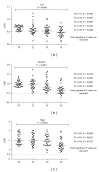Human antibody response to Aedes albopictus salivary proteins: a potential biomarker to evaluate the efficacy of vector control in an area of Chikungunya and Dengue Virus transmission
- PMID: 24822216
- PMCID: PMC4005104
- DOI: 10.1155/2014/746509
Human antibody response to Aedes albopictus salivary proteins: a potential biomarker to evaluate the efficacy of vector control in an area of Chikungunya and Dengue Virus transmission
Abstract
Aedes borne viruses represent public health problems in southern countries and threat to emerge in the developed world. Their control is currently based on vector population control. Much effort is being devoted to develop new tools to control such arbovirus. Recent findings suggest that the evaluation of human antibody (Ab) response to arthropod salivary proteins is relevant to measuring the level of human exposure to mosquito bites. Using an immunoepidemiological approach, the present study aimed to assess the usefulness of the salivary biomarker for measuring the efficacy of Ae. albopictus control strategies in La Reunion urban area. The antisaliva Ab response of adult humans exposed to Ae. albopictus was evaluated before and after vector control measures. Our results showed a significant correlation between antisaliva Ab response and the level of exposure to vectors bites. The decrease of Ae. albopictus density has been detected by this biomarker two weeks after the implementation of control measures, suggesting its potential usefulness for evaluating control strategies in a short time period. The identification of species specific salivary proteins/peptides should improve the use of this biomarker.
Figures



Similar articles
-
Analysis in a murine model points to IgG responses against the 34k2 salivary proteins from Aedes albopictus and Aedes aegypti as novel promising candidate markers of host exposure to Aedes mosquitoes.PLoS Negl Trop Dis. 2019 Oct 16;13(10):e0007806. doi: 10.1371/journal.pntd.0007806. eCollection 2019 Oct. PLoS Negl Trop Dis. 2019. PMID: 31618201 Free PMC article.
-
Human IgG Antibody Response to Aedes Nterm-34kDa Salivary Peptide, an Epidemiological Tool to Assess Vector Control in Chikungunya and Dengue Transmission Area.PLoS Negl Trop Dis. 2016 Dec 1;10(12):e0005109. doi: 10.1371/journal.pntd.0005109. eCollection 2016 Dec. PLoS Negl Trop Dis. 2016. PMID: 27906987 Free PMC article.
-
Evaluation of the human IgG antibody response to Aedes albopictus saliva as a new specific biomarker of exposure to vector bites.PLoS Negl Trop Dis. 2012;6(2):e1487. doi: 10.1371/journal.pntd.0001487. Epub 2012 Feb 21. PLoS Negl Trop Dis. 2012. PMID: 22363823 Free PMC article.
-
[Aedes albopictus, vector of chikungunya and dengue viruses in Reunion Island: biology and control].Parasite. 2008 Mar;15(1):3-13. doi: 10.1051/parasite/2008151003. Parasite. 2008. PMID: 18416242 Review. French.
-
Critical review of the vector status of Aedes albopictus.Med Vet Entomol. 2004 Sep;18(3):215-27. doi: 10.1111/j.0269-283X.2004.00513.x. Med Vet Entomol. 2004. PMID: 15347388 Review.
Cited by
-
IgG Antibody Responses to the Aedes albopictus 34k2 Salivary Protein as Novel Candidate Marker of Human Exposure to the Tiger Mosquito.Front Cell Infect Microbiol. 2020 Jul 29;10:377. doi: 10.3389/fcimb.2020.00377. eCollection 2020. Front Cell Infect Microbiol. 2020. PMID: 32850479 Free PMC article.
-
New Immuno-Epidemiological Biomarker of Human Exposure to Aedes Vector Bites: From Concept to Applications.Trop Med Infect Dis. 2018 Aug 1;3(3):80. doi: 10.3390/tropicalmed3030080. Trop Med Infect Dis. 2018. PMID: 30274476 Free PMC article. Review.
-
Analysis in a murine model points to IgG responses against the 34k2 salivary proteins from Aedes albopictus and Aedes aegypti as novel promising candidate markers of host exposure to Aedes mosquitoes.PLoS Negl Trop Dis. 2019 Oct 16;13(10):e0007806. doi: 10.1371/journal.pntd.0007806. eCollection 2019 Oct. PLoS Negl Trop Dis. 2019. PMID: 31618201 Free PMC article.
-
Serological biomarker for assessing human exposure to Aedes mosquito bites during a randomized vector control intervention trial in northeastern Thailand.PLoS Negl Trop Dis. 2021 May 27;15(5):e0009440. doi: 10.1371/journal.pntd.0009440. eCollection 2021 May. PLoS Negl Trop Dis. 2021. PMID: 34043621 Free PMC article. Clinical Trial.
-
First evaluation of antibody responses to Culex quinquefasciatus salivary antigens as a serological biomarker of human exposure to Culex bites: A pilot study in Côte d'Ivoire.PLoS Negl Trop Dis. 2021 Dec 13;15(12):e0010004. doi: 10.1371/journal.pntd.0010004. eCollection 2021 Dec. PLoS Negl Trop Dis. 2021. PMID: 34898609 Free PMC article.
References
-
- Gratz NG. Critical review of the vector status of Aedes albopictus. Medical and Veterinary Entomology. 2004;18(3):215–227. - PubMed
-
- Gubler DJ. The global emergence/resurgence of arboviral diseases as public health problems. Archives of Medical Research. 2002;33(4):330–342. - PubMed
-
- Gould EA, Gallian P, De Lamballerie X, Charrel RN. First cases of autochthonous dengue fever and chikungunya fever in France: from bad dream to reality! Clinical Microbiology and Infection. 2010;16(12):1702–1704. - PubMed
Publication types
MeSH terms
Substances
LinkOut - more resources
Full Text Sources
Other Literature Sources

